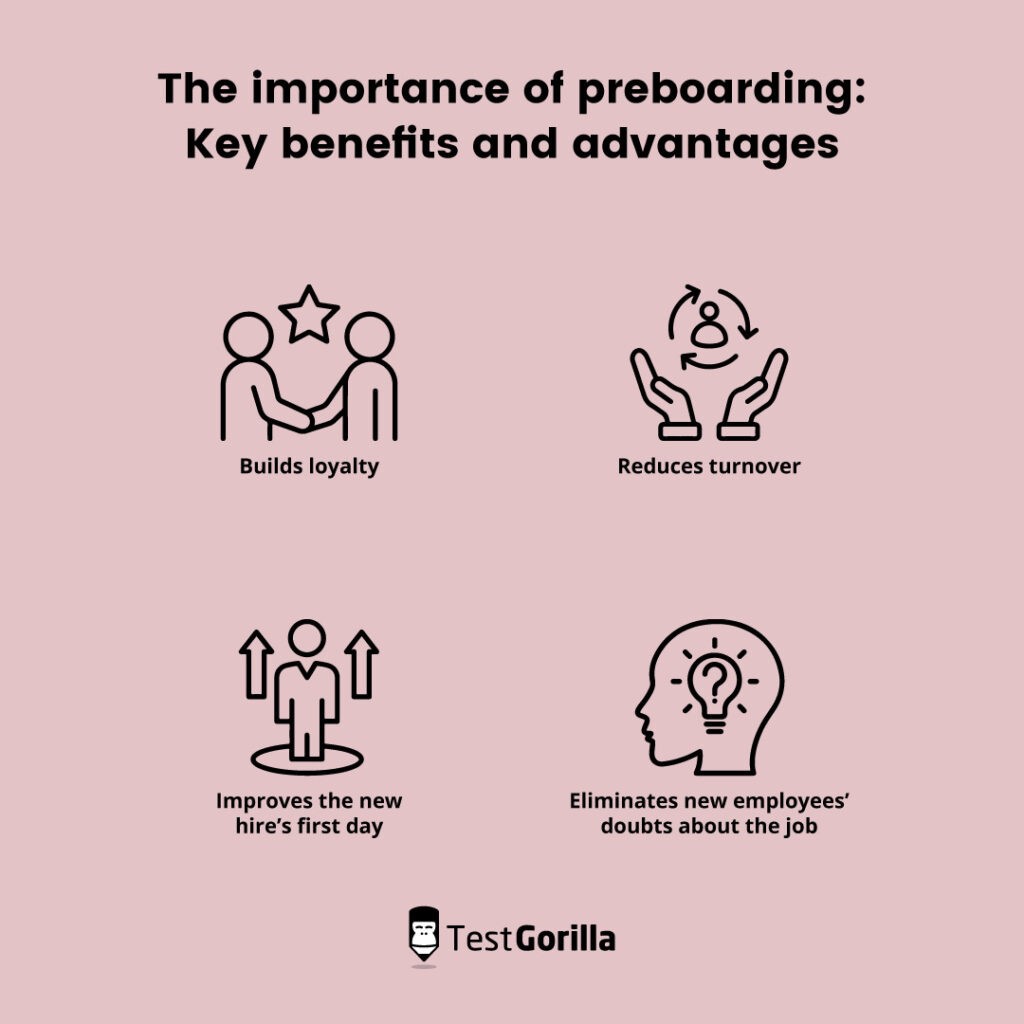What is preboarding? How to empower and support your new hires
Starting a new job can be an exciting and nerve-racking experience.
As an HR professional, it’s important to ensure your new hires feel welcome and supported from day one when they accept a job offer. You can cover much of this during onboarding – but preboarding ensures staff are comfortable with what’s coming and are ready to start.
Investing in preboarding helps set employees up for success and creates a more positive, productive, and communicative work environment.
In this article, we explore preboarding, why it's important, and how to implement it effectively.
Table of contents
- What is preboarding?
- Preboarding vs. onboarding: What’s the difference?
- Key benefits and advantages of preboarding employees
- What should be included in an effective employee preboarding process? 7 must-have steps
- How to preboard employees: 7 best practices
- Set up your new employees for success with a preboarding program
- Preboarding employees FAQs
What is preboarding?
Preboarding is a process that takes place before onboarding. It’s where recruits learn about the company they’re joining and the people they’re working with. During preboarding, HR handles paperwork for new hires, such as insurance, tax, and health and safety declarations.
The preboarding process starts when a new hire accepts a job offer and continues until they start work.
Believe it or not, 20% of workers don’t show up for their first workday because they find better opportunities elsewhere.
You should design a preboarding process to help new hires feel more comfortable and confident about their role and the company.
What does preboarding include?
Activities that increase employee engagement during the preboarding experience include:
Sending a welcome email that includes information about the organization
Providing access to online resources, such as tax forms, insurance details, company intranet, employee handbooks, or training videos
Introducing the hire to their manager and team members
Scheduling informal conversations with current employees
Inviting the hire to company events or social gatherings
Preboarding aims to create a welcoming and informative experience that helps new hires feel valued and excited.
Preboarding vs. onboarding: What’s the difference?
Here are some key differences between preboarding vs. onboarding:
Preboarding | Onboarding |
Begins the moment a candidate accepts a job offer and ensures your new hire arrives | Starts on the first day of employment |
Focuses on engaging with and preparing employees for their roles | Helps new hires settle into work and provides training |
Shows employees what to expect, where they work, and who they work with | Helps recruits use tools and communication channels |
Want to dive deeper into employee onboarding?
Read our complete guide. It’s packed with tips, step-by-step strategies, and industry insights —to build a seamless employee onboarding plan.
The best insights on HR and recruitment, delivered to your inbox.
Biweekly updates. No spam. Unsubscribe any time.
Key benefits and advantages of preboarding employees
Let’s explore why preboarding and onboarding benefit everyone involved.
1. Builds loyalty
A solid preboarding program can help new hires feel like a part of the team before they even arrive for their first day at work and are more appreciative of their employer.
In turn, loyalty improves employee retention and the employee experience.
2. Reduces turnover
Voluntary turnover is estimated to cost US businesses $1tn per year. Finding, training, and keeping new employees is time-consuming and expensive.
However, preboarding helps you build rapport with a new hire and makes them feel like they made the right choice for their new role.
3. Improves the new hire’s first day
Effective preboarding can make new hires feel confident about their first day of work by familiarizing them with your business. Your new hire feels at ease because they already met some colleagues and know what to expect.
If new hires are involved and supported from the beginning, their first day at work should be much less stressful.
4. Eliminates new employees’ doubts about the job
Preboarding can help address first-day jitters by showing what candidates can expect.
The hiring manager goes into more detail during the onboarding process, so that is another difference between preboarding vs. onboarding. Setting up a preboarding checklist offers a “sneak preview,” and a head start for building relationships.
Proving you care about your new employees helps them ease into their jobs, which benefits their productivity.
What should be included in an effective employee preboarding process? 7 must-have steps
Here are seven steps to include in your employee preboarding plan:
A preboarding checklist
A clear roadmap for your hire
Business and role introduction
Insight into your values and culture
Early administrative tasks
Preboarding FAQs
New colleague introductions
Now, here are a few details on each step:
1. A preboarding checklist
When creating your welcome program, you should make a preboarding checklist for new hires to track where each new team member is. This list is similar to an onboarding checklist.
Here’s an example template:
Item | Done? |
Prepare all documentation | |
Set up accounts and work emails | |
Set up workstations and tools | |
Prepare your onboarding program | |
Create a training course or materials | |
Prepare the company’s handbook | |
Send a welcome email | |
Invite the new hire to meetings | |
Schedule meet-and-greets |
Your processes may vary – so use this as a starting point and build on it.
2. A clear roadmap for your hire
Share important dates in the onboarding and preboarding period, such as training and events, to outline the onboarding experience.
Only one in two workers feel they have true role clarity where they work. Boost that clarity early and keep their interest.
3. Business and role introduction
Although it’s best to leave most training for the onboarding program, creating a short preboarding video course explaining your company’s work is worth it.
Introducing the firm is important for recruits because it helps them feel less overwhelmed when starting.
It’s also a good opportunity to familiarize employees with managers so that they know who’s who.
4. Insight into your values and culture
During the preboarding stage, show your recruits why you do what you do for the best first impression.
It’s a good time to reflect on your company’s culture by sharing event footage and staff interviews. New hires are likely to stay with your organization if you show them you have a good culture.
Columbia University research found turnover at companies with a rich culture is just 13.9%, rising to 48.4% at businesses with a poor culture.
5. Early administrative tasks
The preboarding process helps you get any admin tasks done early, including collecting information from the new hire, like their bank details and a copy of their ID.
Processing documents ensures you can focus on getting the hire up and running, regardless of whether they work in-person or remotely.
6. Preboarding FAQs
Use the preboarding process to answer any questions a new hire has.
For example, you can create an FAQ form that includes the following information:
Arrival time
Dress code
Parking
Commuting
Breaks
Preparing this information beforehand helps your new hires know what to expect for their first day on the job, which reduces stress.
7. New colleague introductions
Sending a business-wide email or Slack message introducing the new colleague (and their LinkedIn profile) is an important step of the preboarding process.
A hire shouldn’t start a job only to discover that no one knows about their arrival, so inform everyone about the employee’s starting date. Of course, how you do this depends on the size of your business. If you employ 4,000 people, it may not be relevant to everyone – so only contact the people that your new hire will work with.
How to preboard employees: 7 best practices
Your preboarding process can include many elements, and you may not know where to start or how to make it stand apart from your onboarding program.
Here are a few ideas to add to your preboarding checklist for new hires.
Best practice | Benefits |
Send new hires a welcome package | Encourage brand and firm loyalty |
Ask new colleagues to introduce themselves | Help recruits build rapport |
Invite the new employee to a company event | Help new staff get to know other workers |
Set up a mentor or buddy | Help workers learn by sight |
Check in regularly | Keep channels open so recruits can ask questions |
Use talent assessments to personalize preboarding | Use test results to decide what areas to focus on during onboarding |
Ask for recruitment feedback | Listen to comments to improve your preboarding for future drives |
1. Send new hires a welcome package
Sending a welcome package or company swag is a great way of showing new employees that you care about them and want to build a strong relationship with them.
Many tech giants, like Google and Dropbox, give away apparel when preboarding employees.
Your welcome package could include many things, like T-shirts, hats, and water bottles, with your organization’s logo or branding.
Giving branded products to employees can help boost morale and engagement and create a sense of pride and loyalty.
2. Ask new colleagues to introduce themselves
Consider asking new hires to make a personalized introduction video and help them build rapport.
You could, for instance, give guidelines on what to include in their video and how long it should be. Some recruits are apprehensive about introducing themselves, so make it a choice, not an obligation.
You could even use technology to welcome people into your firm. Baker Tilly, a Dutch accountancy firm, uses a custom-built app to help recruits mingle with their new workforce.
3. Invite new employees to company events
Inviting your new employees to company events helps everyone to get to know each other better.
This strategy gives you a deeper insight into the people you’re hiring and helps you confirm that you’ve made the right choices.
New hires meet their colleagues in an informal setting, so they already have something in common when they start work.
4. Set up a mentor or buddy
Many people thrive when shadowing existing staff before they start.
Therefore, consider finding someone in your team willing to act as a mentor for recruits. Make this another choice, not an obligation.
5. Check in regularly
Setting up a roadmap and providing contact details for further questions are good initial steps.
However, you shouldn’t crowd your new hires because some prefer to find their way. Keeping a contact channel open ensures staff know they can ask for help.
6. Use talent assessments to personalize preboarding
Skills testing is one of several preboarding and onboarding best practices we recommend.
Let's say you hire a programmer. They may pass general tests but show room for improvement in specific coding languages. During preboarding, you could use talent assessment results to shape individual training packages for their onboarding process.
You’re effectively building preboarding and onboarding based on test results.
For instance, a recruit scoring exceptionally on communication tests could benefit more from mentoring than others.
Here’s how you can set up a custom assessment through TestGorilla for onboarding:
Take the TG demo for a test drive to try these features before your next preboarding drive.
Moreover, talent assessments during preboarding improve your chances of retaining high-quality performers.
Design Pickle adopted TestGorilla to help improve the quality of hire and now runs an efficient onboarding process that inspires creative talent to stick around.
Research suggests most organizations don’t start assessing candidates until after onboarding. Bucking that trend means you get a better understanding of the people you’re hiring:
Improve your preboarding process with talent assessments
Are you ready to use talent assessments to optimize your hiring and preboarding processes?
7. Ask for recruitment feedback
Asking for feedback from staff helps you gain fresh insight into your hiring process, helping you improve it. The new employee can express their thoughts and feel valued, building additional rapport and a sense of belonging.
Create a brief questionnaire about the candidate’s experience using relevant questions to gather useful information.
Think carefully about the preboarding elements you want most of all feedback for.
If you’re starting with skills-based hiring and want to know if your recruits are enjoying the process, you should ask them clearly. You may find recruits liked questions such as these from TestGorilla’s Data Analysis Using R test:
If you’re interested in more sample questions, check out the Data Analysis Using R test preview.
Set up your new employees for success with a preboarding program
Preboarding is an important step to help reduce employee turnover and ensure new hires show up for their first day at work.
Unlike new employee onboarding, your preboarding program can help build loyalty, expand brand awareness, and eliminate doubts in new employees’ minds.
Following the best practices outlined in this article can create an engaging and exciting welcome that people genuinely want to stick around for.
You can use TestGorilla assessments during preboarding, meaning you confidently align top talent for hundreds of roles. Take a product tour and see our software’s best features for yourself.
From there, get into the driving seat with your 30-minute demo.
And when you’re ready to start, sign up for a free forever plan and preboard people you want to keep around.
Preboarding employees FAQs
Let’s close with some common queries you may have while learning how to preboard employees.
What is the preboarding process in HR?
Preboarding is the first step between hiring an employee and welcoming them to their first day on the job. It’s a process where HR prepares important documents, answers questions, and introduces recruits to their new teams and co-workers. It forms a key part of the HR fundamentals test.
What is pre-onboarding for new employees?
For new employees, preboarding offers a chance to learn how their employer operates, what they stand for, and what they expect in their first weeks in a role. It's a good chance for new hires to ask any important questions, file paperwork, and get to know the people they're working with.
How long do preboarding and onboarding usually take?
Preboarding usually takes place a few days to a week while HR sets recruits up for onboarding. Virtual onboarding can take weeks to a full year, depending on what a business needs to get people up to speed.
What happens in a pre-onboarding session?
A typical preboarding session for a recruit can include filling out specific paperwork, meeting members of their new team, or attending an event. There are no set rules for preboarding, so read our guide to learn more about what you could include for the best results.
What is a preboarding checklist for new hires?
Completing and submitting documents, like a benefits guide
Welcoming recruits to the company
Informing teams of a new arrival
Preparing tools
Answering questions
Sending welcome packages
Arranging event invites
Setting up a first week’s schedule
Creating a training program
Ensuring recruits know what you expect of them
You've scrolled this far
Why not try TestGorilla for free, and see what happens when you put skills first.




















